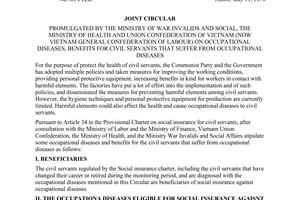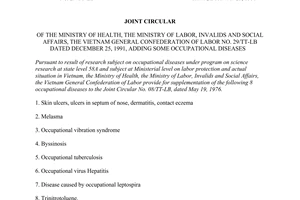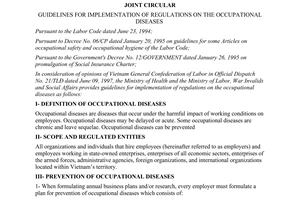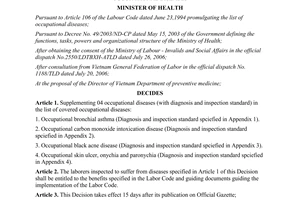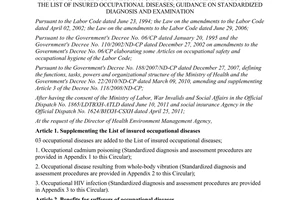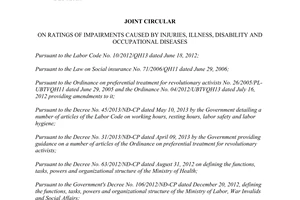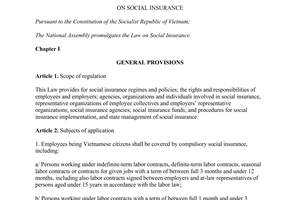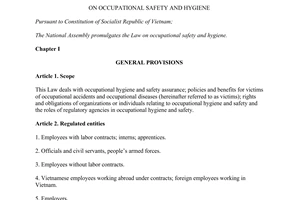Nội dung toàn văn Circular 15/2016/TT-BYT regulations occupational diseases covered by social insurance
|
MINISTRY OF
HEALTH |
SOCIALIST
REPUBLIC OF VIETNAM |
|
Hanoi, May 15, 2016 |
CIRCULAR
ON REGULATIONS ON OCCUPATIONAL DISEASES COVERED BY SOCIAL INSURANCE
Pursuant to the Labor Code No.10/2012/QH13 dated June 18, 2012;
Pursuant to the Law on Social Insurance No. 58/2014/QH13 dated November 20, 2014;
Pursuant to the Law on Occupational Safety and Health No.84/2015/QH13 dated June 25, 2015;
Pursuant to Decree No.37/2016/ND-CP dated May 15, 2016 of the Government providing for details and guidelines for some articles of the Law on Occupational Safety and Health regarding compulsory insurance for occupational accidents and diseases;
Pursuant to Decree No.63/2012/ND-CP dated August 31, 2012 of the Government on functions, missions, rights and organizational structure of the Ministry of Health;
At the request of the Director of Health Environmental Management Department;
The Minister of Health promulgates Circular on regulations on occupational diseases covered by social insurance,
Article 1. Scope
This Circular deals with the list of occupational diseases covered by social insurance and provides guidelines for diagnosis and assessment of occupational diseases.
Article 2. Definitions
For the purpose of this Circular, the terms below shall be construed as follows:
1. “minimum exposure limit” means the lowest level of exposure to occupational hazards during the working process resulting in occupational diseases.
2. "minimum exposure period” means the shortest period of exposure to occupational hazards during the working process which could cause occupational diseases.
3. “latency period” means the period over which the employees is still susceptible to occupational diseases although he/she is no longer exposure to the occupational hazards.0}
Article 3. List of occupational diseases covered by social insurance and guidelines for diagnosis and examination.
1. Occupational silicosis and guidelines for diagnosis and assessment prescribed in Appendix 1 issued together with this Circular.
2. Occupational asbestosis and guidelines for diagnosis and assessment prescribed in Appendix 2 issued together with this Circular.
3. Occupational byssinosis and guidelines for diagnosis and assessment prescribed in Appendix 3 issued together with this Circular. .
4. Occupational talc pneumoconiosis lung disease and guidelines for diagnosis and assessment prescribed in Appendix 4 issued together within this Circular.
5. Occupational coalworker's pneumoconiosis and guidelines for diagnosis and assessment prescribed in Appendix 5 issued together with this Circular.
6. Occupational chronic bronchitis and guidelines for diagnosis and assessment prescribed in Appendix 6 issued together with this Circular.
7. Occupational asthma and guidelines for diagnosis and assessment prescribed in Appendix 7 issued together with this Circular.
8. Occupational lead poisoning and guidelines for diagnosis and assessment prescribed in Appendix 8 issued together with this Circular.
9. Occupational intoxication of benzene and benzene homologues and guidelines for diagnosis and assessment prescribed in Appendix 9 issued together with this Circular.
10. Occupational mercurialism and guidelines for diagnosis and assessment prescribed in Appendix 10 issued together with this Circular.
11. Occupational manganism and guidelines for diagnosis and assessment prescribed in Appendix 11 issued together with this Circular.
12. Occupational trinitrotoluene poisoning and guidelines for diagnosis and assessment prescribed in Appendix 12 issued together with this Circular.
13. Occupational asernic poisoning and guidelines for diagnosis and assessment prescribed in Appendix 13 issued together with this Circular.
14. Occupational intoxication of pesticide chemicals and guidelines for diagnosis and assessment prescribed in Appendix 14 issued together with this Circular.
15. Occupational nicotine poisoning and guidelines for diagnosis and assessment prescribed in Appendix 15 issued together with this Circular.
16. Occupational carbon monoxide poisoning and guidelines for diagnosis and assessment prescribed in Appendix 16 issued together with this Circular.
17. Occupational cadmium poisoning and guidelines for diagnosis and assessment prescribed in Appendix 17 issued together with this Circular.
18. Noise-induced hearing loss and guidelines for diagnosis and assessment prescribed in Appendix 18 issued together with this Circular.
19. Occupational decompression sickness and guidelines for diagnosis and assessment prescribed in Appendix 19 issued together with this Circular.
20. Occupational whole-body vibration and guidelines for diagnosis and assessment prescribed in Appendix 20 issued together with this Circular.
21. Occupational local vibration and guidelines for diagnosis and assessment prescribed in Appendix 21 issued together with this Circular.
22. Occupational radiation toxicity and guidelines for diagnosis and assessment prescribed in Appendix 22 issued together with this Circular.23. Occupational cataract and guidelines for diagnosis and assessment prescribed in Appendix 23 issued together with this Circular.
24. Occupational black acne disease and guidelines for diagnosis and assessment prescribed in Appendix 24 issued together with this Circular.
25. Occupational melasma and guidelines for diagnosis and assessment prescribed in Appendix 25 issued together with this Circular.
26. Occupational chromium contact dermatitis and guidelines for diagnosis and assessment prescribed in Appendix 26 issued together with this Circular.
27. Occupational skin diseases due to prolonged wet and cold exposure and guidelines for diagnosis and assessment prescribed in Appendix 27 issued together with this Circular.
28. Occupational skin diseases due to exposure to natural rubber and rubber additive chemicals and guidelines for diagnosis and assessment prescribed in Appendix 28 issued together with this Circular.
29. Occupational leptospirosis and guidelines for diagnosis and assessment prescribed in Appendix 29 issued together with this Circular.
30. Occupational hepatitis B and guidelines for diagnosis and assessment prescribed in Appendix 30 issued together within this Circular.
31. Occupational tuberculosis and guidelines for diagnosis and assessment prescribed in Appendix 31 issued together with this Circular.
32. HIV infection due to occupational accidents and guidelines for diagnosis and assessment prescribed in Appendix 32 issued together with this Circular.
33. Occupational hepatitis C and guidelines for diagnosis and assessment prescribed in Appendix 33 issued together with this Circular.
34. Occupational mesotholioma cancer and guidelines for diagnosis and assessment prescribed in Appendix 34 issued together with this Circular.
Article 3. Principles for diagnosis, treatment and preventive for employees getting occupational diseases
1. An employee diagnosed with an occupational disease is required to:
have his/her exposure to occupational hazards causing that occupational disease limited.
b) be treated following clinical guidelines of the Ministry of Health For occupational intoxication, instant detoxification is required;
undergo rehabilitation and assessment of work ability reduction to claim insurance as regulated
2. For some occupational diseases such as noise-induced hearing loss, local vibration, whole-body vibration, manganism poisoning, dust lung diseases except from byssinosis, occupational cancers or cancers caused by occupational diseases without the possibility of long-term treatment, patients are required to be immediately transferred for medical examination.
3. Diagnosis of occupational intoxication made during the latency period is not required toxicity testing.
Article 4. Implementation
1. Health Environmental Management Department:
a) Preside over and cooperate with relevant agencies in achieving, preliminarily and officially reviewing the implementation of this Circular nationwide.
a) Preside over and cooperate with relevant agencies in preparing new documents or amending and providing guidelines for documents on:
- List of occupational diseases covered by social insurance
- Guidelines for diagnosis of occupational diseases including definition of the disease, causing factors, occupations or jobs contacting to the disease, minimum exposure limit, minimum exposure period, latency period, clinical, subclinical and other relevant contents.
- Guidelines for assessment of work ability reduction due to occupational diseases or called bodily injury rate.
c) Examine, inspect and impose penalties for violations as regulated by laws
2. Medical Examination and Treatment Management Department shall preside over and cooperate with Health Environmental Management Agency in developing new clinical protocol or amending clinical protocol for treatment of occupational diseases specified in the list of occupational diseases being covered by social insurance.
3. Department of Health of centrally-affiliated provinces and cities:
a) Instruct labor facilities, entities, and agencies under management to implement this Circular;
b) Propose new diseases related to occupations according to criteria prescribed in Clause 4 of this Article
c) Examine, inspect and impose penalties for violations as regulated by laws
4. Preventive healthcare-related Academies, Universities of Medicine, Pharmacy:
Take the initiative in conducting researches, proposing new diseases or features related to occupations so as for the Ministry of Health (Health Environmental Management Department) to consider and add them to this list of occupational diseases covered by social insurance according to the following criteria:
a) The connection between the exposure to occupational hazards during the working process and a particular disease is successfully discovered. Some diseases could be found after years of first exposure to occupational hazards during the working process although employees are retired or change their job.
b) Employees exposed to occupational hazards are likely to get diseases compared to those without exposure.
c) Some diseases in workplace caused by exposure to occupational hazards during the working process failing to be researched due to lack of eligibility but internationally recognized as covered occupational diseases may be added to the list of occupational diseases covered by social insurance in Vietnam
5. Health agencies of other ministries
a) Propose new diseases, features related to occupations according to criteria prescribed in Clause 4 of this Article;
b) Instruct medical facilities to comply with regulations in force of the law on health examination for soon discovery of occupational diseases; regularly check and impose strict penalties on organizations and individuals for occupation diseases law violations.
6. Labor facilities, occupational disease examination facilities, trade union of all levels and relevant agencies, organizations, individuals shall make a proposed report of supplement of new diseases related to industries, occupations according to criteria prescribed in Clause 4 of this Article
Article 5. Reference provisions
If documents mentioned in this Circular are replaced or amended, implementation of the Circular must follow the replaced or amended ones.
Article 6. Effect
1. This Circular comes into force from July 01, 2016.
2. Documents below will be out of effect from the
day on which this Circular comes into force:
Joint Circular No.08/TT-LB dated May 19, 1976 of the Ministry of Health, War
Invalids and Social Affairs, Vietnam General Confederation of Labor on
occupational diseases and preferential policy for officials, public employees
getting occupational diseases; Joint Circular No.29/TT-LB dated October 25,
1991 of the Ministry of Health, Labor-War Invalids and Social Affairs and
Vietnam General Confederation of Labor on amendment to occupational diseases;
Decision No.167/BYT-QD dated February 04, 1997 of the Ministry of Health on
adding 5 occupational diseases to the list of occupational diseases covered by
social insurance; Decision No.27/QD-BYT dated September 21, 2006 of the
Ministry of Health on adding 4 occupational diseases to the list of
occupational diseases covered by social insurance; Circular No.42/2011/TT-BYT
dated November 30, 2011 of the Ministry of Health on adding occupational
diseases including Cadmium poisoning, whole-body vibration and HIV infection
due to occupational accidents to the list of occupational diseases covered by
social insurance and providing guidelines for standards for diagnosis and
assessment; Circular No.36/2014/TT-BYT dated November 14, 2014 of the Ministry
of Health on adding occupational Coalworker's pneumoconiosis to the list of occupational
diseases covered by social insurance and providing guidelines for diagnosis and
assessment; Table of 3 bodily injury rates due to occupational diseases
specified in Circular No.28/2013/TTLT-BYT-BLDTBXH dated September 2013 of
inter-ministries of Health, Labor-War Invalids and Social Affairs on
regulations on bodily injury rate due to injury, diseases and occupational
diseases; Section V and VII of Joint Circular No.08/1998/TTLT-BYT-BLDTBXH dated
April 20, 1998 of inter-Ministries of Health, Labor-War Invalids and Social
Affairs providing guidelines for regulations on occupational diseases
|
|
PP. MINISTER |
------------------------------------------------------------------------------------------------------
This translation is made by LawSoft and
for reference purposes only. Its copyright is owned by LawSoft
and protected under Clause 2, Article 14 of the Law on Intellectual Property.Your comments are always welcomed
